Reminiscing

 Once a year, we find ourselves puttin’ on a little bit o’ the Irish style, to step out and partake of the green Guinness beer, Corned Beef and Cabbage, and a number of other Irish treats, as we celebrate Saint Patrick’s Day. The day really isn’t about wearing green clothes, so you don’t get pinched, or drinking green beer, but rather a day to celebrate Saint Patrick, who came to Ireland in the fifth century and brought many of the people to Christ. In fact, in Ireland, the day is not a party day, but rather, a religious holiday, similar to Christmas and Easter. Things have changed some over the years, and these days you can find Saint Patrick’s Day parades, shamrocks, and green Guinness beer in Ireland, but it’s mostly there for the tourists who think that is the right way to celebrate the day. For most of the Irish people, however it would not be that way, and in fact, up until 1970 Irish laws mandated that pubs be closed on Saint Patrick’s Day. That is a stark contrast to the way the day is celebrated here, but the holiday doesn’t mean the same thing to Americans. I suppose that our Independence Day doesn’t mean the same thing to the Irish either.
Once a year, we find ourselves puttin’ on a little bit o’ the Irish style, to step out and partake of the green Guinness beer, Corned Beef and Cabbage, and a number of other Irish treats, as we celebrate Saint Patrick’s Day. The day really isn’t about wearing green clothes, so you don’t get pinched, or drinking green beer, but rather a day to celebrate Saint Patrick, who came to Ireland in the fifth century and brought many of the people to Christ. In fact, in Ireland, the day is not a party day, but rather, a religious holiday, similar to Christmas and Easter. Things have changed some over the years, and these days you can find Saint Patrick’s Day parades, shamrocks, and green Guinness beer in Ireland, but it’s mostly there for the tourists who think that is the right way to celebrate the day. For most of the Irish people, however it would not be that way, and in fact, up until 1970 Irish laws mandated that pubs be closed on Saint Patrick’s Day. That is a stark contrast to the way the day is celebrated here, but the holiday doesn’t mean the same thing to Americans. I suppose that our Independence Day doesn’t mean the same thing to the Irish either.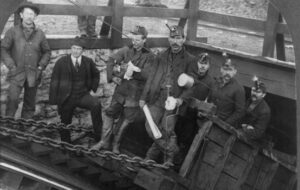
In the United States, Saint Patrick’s Day is a day to celebrate out Irish roots, and to participate in a little playful silliness. We celebrate with “pub crawls” and green coloring in rivers. While the Chicago River is the most prominent green river on Saint Patrick’s Day, there are currently others working to emulate the same effects or have done so in the past. The Irish Marching Society decided to bring the tradition to Rockford, Illinois and dye Rock River last year. San Antonio, Texas; Savannah, Georgia; Indianapolis, Indiana; Charlotte, North Carolina; Tampa, Florida; and Washington DC have all dyed various rivers green. In 2020, city officials in Dublin, Ireland decided to get in on the fun by dying the River Liffey green…as a way to get everyone involved.
I think most of us have some Irish background, but people may not know it. It seems to me that a lot of people have immigrated from Ireland over the years. In fact, many industries like mining and the rail roads, likely 
 would have been a ways behind where they were with the Irish immigrants. With the number of Irish immigrants that came over, there are probably very few families who don’t have a least a little bit of the Irish in them. Nevertheless, Irish or not, most of us like to celebrate the wearin’ of the green every year when Saint Paddy’s Day rolls around. So, whether you drink green beer or eat corned beef and cabbage, or simply wear green so you don’t get pinched, happy Saint Patrick’s Day to you all!!
would have been a ways behind where they were with the Irish immigrants. With the number of Irish immigrants that came over, there are probably very few families who don’t have a least a little bit of the Irish in them. Nevertheless, Irish or not, most of us like to celebrate the wearin’ of the green every year when Saint Paddy’s Day rolls around. So, whether you drink green beer or eat corned beef and cabbage, or simply wear green so you don’t get pinched, happy Saint Patrick’s Day to you all!!

 When you live on a farm, with multiple animals, the work never ends. My nephew, Eric Parmely married a girl named Ashley, who was raised on a farm, and they are on a life journey that is probably pretty unusual in this day and age. They bought a farm west of Casper, Wyoming, and they both work very hard raising horses, cows, goats, pigs, turkeys, and chickens, not to mention dogs and cats. The baby count grows every year, and of course, the animals supply the family with meat, eggs, milk, and of course, love…especially from the dogs and cats, but from the other animals too.
When you live on a farm, with multiple animals, the work never ends. My nephew, Eric Parmely married a girl named Ashley, who was raised on a farm, and they are on a life journey that is probably pretty unusual in this day and age. They bought a farm west of Casper, Wyoming, and they both work very hard raising horses, cows, goats, pigs, turkeys, and chickens, not to mention dogs and cats. The baby count grows every year, and of course, the animals supply the family with meat, eggs, milk, and of course, love…especially from the dogs and cats, but from the other animals too.
Eric’s workday doesn’t really end until his head the pillow. Eric is always working on something. Eric and Ashley host a family dinner for our families once a month, and after dinner, the work must usually go on. Sunday when we were out there, he and several of the men were out working on his 
 tractor. You can’t run a farm without a tractor, and there is always something that needs done on it…either repairs or maintenance. Then he and Ashley have jobs like milking the cow and the goats, feeding all the animals, and stacking hay (when they buy bales).
tractor. You can’t run a farm without a tractor, and there is always something that needs done on it…either repairs or maintenance. Then he and Ashley have jobs like milking the cow and the goats, feeding all the animals, and stacking hay (when they buy bales).
Eric is a great daddy. He gives the best “daddy horse” rides and tickles…which we all know is very important…especially the tickles to his kids, Reagan, Hattie, Bowen, and Maeve!! He is always helping Ashley with the household chores and is an expert at washing dishes and folding laundry. You might say he has dozens and dozens of babies, because he also loves to snuggle the kittens and puppies, and he helps pull calves. Eric really has a heart of gold and is filled with love for his kids, wife, and animals.
In the little bit of down time he has, Eric likes to watch videos on YouTube on his phone and giggles to himself. 
 He rather reminds me of his Uncle Bob in that way. It doesn’t matter if it’s on television or his phone, Bob gets a kick out of comedy, just like Eric. It’s fun to listen to their laughter from the other room, and ultimately, you can’t help but laugh along, even if you don’t know what is so funny. Just hearing their laughter is contagious, and you find yourself laughing along…or at the very least smiling. Ashley tells me that Eric is still a mama’s boy, and that is likely true. I think Eric would help his mom, Jennifer Parmely and her partner, Brian Cratty with anything they needed, and I think he would help his in-laws, Kari and Albert Eighmy with anything they needed too. That’s just the kind of guy Eric is. Today is Eric’s birthday. Happy birthday Eric!! Have a great day!! We love you!!
He rather reminds me of his Uncle Bob in that way. It doesn’t matter if it’s on television or his phone, Bob gets a kick out of comedy, just like Eric. It’s fun to listen to their laughter from the other room, and ultimately, you can’t help but laugh along, even if you don’t know what is so funny. Just hearing their laughter is contagious, and you find yourself laughing along…or at the very least smiling. Ashley tells me that Eric is still a mama’s boy, and that is likely true. I think Eric would help his mom, Jennifer Parmely and her partner, Brian Cratty with anything they needed, and I think he would help his in-laws, Kari and Albert Eighmy with anything they needed too. That’s just the kind of guy Eric is. Today is Eric’s birthday. Happy birthday Eric!! Have a great day!! We love you!!

 My niece, Kellie Hadlock has been in a period of growth. So much is changing in her life. A while back, Kellie bought her own house, and now, she has time and space to grow…and grow she is. Kellie has been concentrating on her relationship with the Lord. She is now fully engaged in daily Bible study, and you can actually see that she is growing in knowledge and in truth, and that the Word she is reading is planted deeply in her heart. Kellie has been one of the worship leaders in our church, Word Christian Fellowship Church, for a number of years now, and the love she has for the Lord shows in every song she sings. Kellie has always been a “smiley girl,” and that has served her well in her role as worship leader. I know that as one of the backup singers, I always tell myself to watch Kellie, so I remember to smile too, because I tend to be more serious. She has helped me more than she will ever know. It is wonderful, for all who know Kellie, to see her actively growing in her relationship with the Lord, and as worship leader. She is becoming a great woman of God!!
My niece, Kellie Hadlock has been in a period of growth. So much is changing in her life. A while back, Kellie bought her own house, and now, she has time and space to grow…and grow she is. Kellie has been concentrating on her relationship with the Lord. She is now fully engaged in daily Bible study, and you can actually see that she is growing in knowledge and in truth, and that the Word she is reading is planted deeply in her heart. Kellie has been one of the worship leaders in our church, Word Christian Fellowship Church, for a number of years now, and the love she has for the Lord shows in every song she sings. Kellie has always been a “smiley girl,” and that has served her well in her role as worship leader. I know that as one of the backup singers, I always tell myself to watch Kellie, so I remember to smile too, because I tend to be more serious. She has helped me more than she will ever know. It is wonderful, for all who know Kellie, to see her actively growing in her relationship with the Lord, and as worship leader. She is becoming a great woman of God!!
As an aunt, she is among the most beloved aunts I know. Her nephew, Ethan Hadlock, and nieces, Aurora 
 Hadlock, Adelaide Sawdon, and Mackenzie Moore, flock to her whenever she is near. She loves children and is a great “step-mom” to her boyfriend, Tim Thompson’s daughter, Jolene. She is also a great “doggie mom” to her little puppy, Leena and to Tim’s dog, Jett. Unfortunately, Kellie and Tim don’t live in the same city right now, so they have been spending time going back and forth visiting each other in their long distance (but not too far, only from Casper, Wyoming to Gillette, Wyoming) relationship. Lovebirds will always find a way, and these two have made it work.
Hadlock, Adelaide Sawdon, and Mackenzie Moore, flock to her whenever she is near. She loves children and is a great “step-mom” to her boyfriend, Tim Thompson’s daughter, Jolene. She is also a great “doggie mom” to her little puppy, Leena and to Tim’s dog, Jett. Unfortunately, Kellie and Tim don’t live in the same city right now, so they have been spending time going back and forth visiting each other in their long distance (but not too far, only from Casper, Wyoming to Gillette, Wyoming) relationship. Lovebirds will always find a way, and these two have made it work.
And speaking of Tim…he has really brought Kellie out of her wheelhouse and into activities that none of us would have ever expected Kellie to be involved in. Tim is an outdoorsman, and he has taken Kellie along with 
 him on his trips. She, of course, was open to going and has found that she really loves doing things like hunting, ice fishing, axe throwing, and archery. As her sister Lindsay Moore said, and I agree…Who saw that coming?!? Kellie really never seemed the “woman of the great outdoors” type, with the exception of going camping. Of course, when I say camping, I mean in a travel trailer and mostly sitting around the campfire. Now, all that has changed. She’s like “Annie Oakley” or something, and for her it’s a whole new wheelhouse. Kellie has always had a positive outlook on life, and she is open-minded, so it shouldn’t have been so surprising. Nevertheless, somehow it was. She’s a whole new Kellie. Today is Kellie’s birthday. Happy birthday Kellie!! Have a great day!! We love you!!
him on his trips. She, of course, was open to going and has found that she really loves doing things like hunting, ice fishing, axe throwing, and archery. As her sister Lindsay Moore said, and I agree…Who saw that coming?!? Kellie really never seemed the “woman of the great outdoors” type, with the exception of going camping. Of course, when I say camping, I mean in a travel trailer and mostly sitting around the campfire. Now, all that has changed. She’s like “Annie Oakley” or something, and for her it’s a whole new wheelhouse. Kellie has always had a positive outlook on life, and she is open-minded, so it shouldn’t have been so surprising. Nevertheless, somehow it was. She’s a whole new Kellie. Today is Kellie’s birthday. Happy birthday Kellie!! Have a great day!! We love you!!

 The town of Spencer, Nebraska is a small town of just 423 people, but on March 14, 2019, the town became more well known that it probably ever dreamed it could, or even wanted to be. Suddenly, Spencer, Nebraska was big news, or at least the dam there was. Events unfolded that lead to the collapse of the 93-year-old dam, when the pressure from an icy flood mixed with an area that had a history of unaddressed ice problems. Perhaps it was the rural area of the state, or that they misjudged the surge that could follow a collapse, but they didn’t think that many people would be affected and certainly that no one would die, should the Spencer dam fail. That proved to be untrue, when Kenny Angel, who lived just beneath the dam, was found dead after the flood washed away his home and business. Workers for the Nebraska Public Power District, which operated the dam, warned Angel just minutes ahead of time of the impending danger.
The town of Spencer, Nebraska is a small town of just 423 people, but on March 14, 2019, the town became more well known that it probably ever dreamed it could, or even wanted to be. Suddenly, Spencer, Nebraska was big news, or at least the dam there was. Events unfolded that lead to the collapse of the 93-year-old dam, when the pressure from an icy flood mixed with an area that had a history of unaddressed ice problems. Perhaps it was the rural area of the state, or that they misjudged the surge that could follow a collapse, but they didn’t think that many people would be affected and certainly that no one would die, should the Spencer dam fail. That proved to be untrue, when Kenny Angel, who lived just beneath the dam, was found dead after the flood washed away his home and business. Workers for the Nebraska Public Power District, which operated the dam, warned Angel just minutes ahead of time of the impending danger.
The dam was operated by the Nebraska Public Power District (NPPD). Heavy precipitation during the March 2019 North American blizzard led to a failure of the dam in the early morning hours of March 14th, causing heavy flooding downstream. For a dam that was not expected to do much damage, if it failed, the damage was really devastating…affecting four counties. An 11-foot wall of water was released by the failure, as recorded by a US Geological Survey stream gage moments before it was washed away.
Nebraska regulators had categorized Spencer Dam as a “significant hazard,” which is a rating that meant no loss of life was expected if it failed. With that, no formal emergency action plan was required. After the collapse, it was noted that the Association of State Dam Safety Officials said the dam should have been rated as “high hazard,” which could have led to a plan to modify it to increase its flood capacity. Unfortunately, that was not done, and the failure was terrible. Knox County, the hardest hit of the four counties affected, saw estimates of more than $17M in damages. While the Spencer dam had a history of ice related issues, and other dams may have had ice issues too, the Spencer dam might just be the first dam in the nation to collapse due to 
 those ice issues. The 11-foot surge of water that followed the collapse took out roads, highways, homes, businesses, and bridges. For several months, motorists were required to detour 150 miles to get past the damage. The flood cut a new channel in the river, meaning a new 1050-foot section of the bridge on Highway 281 below the dam.
those ice issues. The 11-foot surge of water that followed the collapse took out roads, highways, homes, businesses, and bridges. For several months, motorists were required to detour 150 miles to get past the damage. The flood cut a new channel in the river, meaning a new 1050-foot section of the bridge on Highway 281 below the dam.
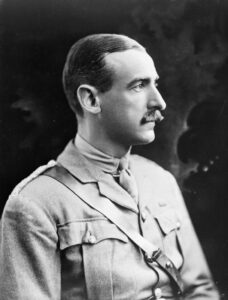 The unkillable soldier…a nickname that has deep ramifications, and a nickname no one really wants to have. It indicates that the soldier is wounded multiple times…and somehow survived. General Adrian Carton de Wiart was that soldier. He was born into an aristocratic family in Brussels, on May 5, 1880. He was the eldest son of Léon Constant Ghislain Carton de Wiart and Ernestine Wenzig. He spent his early days in Belgium and in England. When he was six years old, his parents divorced, and he moved with his father to Cairo. His mother remarried Demosthenes Gregory Cuppa later in 1886. His father was a lawyer and magistrate, as well as a director of the Cairo Electric Railways and Heliopolis Oases Company and was well connected in Egyptian governmental circles. Adrian Carton de Wiart learned to speak Arabic. He joined the British Army at the time of the Second Boer War around 1899, where he entered under the false name of “Trooper Carton,” claiming to be 25 years old, but he was actually 20. He was wounded in the stomach and groin in South Africa early in the Second Boer War and was sent home to recuperate. His father was furious when he learned his son had abandoned his studies. Nevertheless, he allowed his son to remain in the army.
The unkillable soldier…a nickname that has deep ramifications, and a nickname no one really wants to have. It indicates that the soldier is wounded multiple times…and somehow survived. General Adrian Carton de Wiart was that soldier. He was born into an aristocratic family in Brussels, on May 5, 1880. He was the eldest son of Léon Constant Ghislain Carton de Wiart and Ernestine Wenzig. He spent his early days in Belgium and in England. When he was six years old, his parents divorced, and he moved with his father to Cairo. His mother remarried Demosthenes Gregory Cuppa later in 1886. His father was a lawyer and magistrate, as well as a director of the Cairo Electric Railways and Heliopolis Oases Company and was well connected in Egyptian governmental circles. Adrian Carton de Wiart learned to speak Arabic. He joined the British Army at the time of the Second Boer War around 1899, where he entered under the false name of “Trooper Carton,” claiming to be 25 years old, but he was actually 20. He was wounded in the stomach and groin in South Africa early in the Second Boer War and was sent home to recuperate. His father was furious when he learned his son had abandoned his studies. Nevertheless, he allowed his son to remain in the army.
In 1908, he married Countess Friederike Maria Karoline Henriette Rosa Sabina Franziska Fugger von Babenhausen (1887 – 1949), eldest daughter of Karl, 5th Fürst (Prince) von Fugger-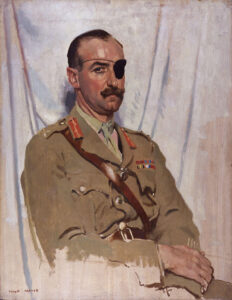 Babenhausen and Princess Eleonora zu Hohenlohe-Bartenstein und Jagstberg of Klagenfurt, Austria. They had two daughters, the elder of whom Anita (born 1909, now deceased) was the maternal grandmother of the war correspondent Anthony Loyd (born 1966). I wonder if Loyd was inspired by his grandfather’s story.
Babenhausen and Princess Eleonora zu Hohenlohe-Bartenstein und Jagstberg of Klagenfurt, Austria. They had two daughters, the elder of whom Anita (born 1909, now deceased) was the maternal grandmother of the war correspondent Anthony Loyd (born 1966). I wonder if Loyd was inspired by his grandfather’s story.
Over the course of his career, General Adrian Carton de Wiart earned the nickname “the unkillable soldier.” By 1915, he was promoted to captain and had already survived his first war…the Boer War. One night, near the French battlefield of Ypres, he and a small group of officers wandered too far into enemy territory and ran into a group of German soldiers, who fired. De Wiart was badly shot in the hand but scrambled back to his regiment. According to his memoirs, he used a “scarf he’d taken off a slain German soldier to stop the bleeding.” He was taken to a hospital where surgeons debated what to do about the gory mess of dangling fingers that had been his hand. De Wiart said, “I asked the doctor to take my fingers off; he refused, so I pulled them off myself and felt absolutely no pain in doing it.” De Wairt’s injuries were not over yet. The hand became infected and later had to be amputated. Three weeks later, De Wiart and returned to duty. He was shot several more times in his career, survived two plane crashes, and lost an eye. Over the course of four conflicts, 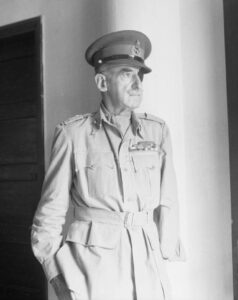 he sustained 11 grievous injuries, and simply could not be killed in war.
he sustained 11 grievous injuries, and simply could not be killed in war.
En route home via French Indochina, Carton de Wiart stopped in Rangoon as a guest of the army commander. Coming down the stairs, he slipped on coconut matting, fell down, broke several vertebrae, and knocked himself unconscious. He was admitted to Rangoon Hospital where he was treated and recovered. His wife died in 1949. Then, in 1951, at the age of 71, he married Ruth Myrtle Muriel Joan McKechnie, a divorcee known as Joan Sutherland, 23 years his junior (born in late 1903, she died January 13, 2006, at the age of 102.) They settled at Aghinagh House, Killinardrish, County Cork, Ireland. Carton de Wiart died at the age of 83 on June 5, 1963. He left no papers. He and his wife Joan are buried in Caum Churchyard just off the main Macroom road. The grave site is just outside the actual graveyard wall on the grounds of his own home.
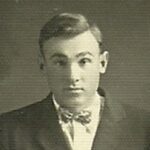
 When my husband, Bob’s grandfather, Andy Schulenberg was a boy of 14 years, he was involved in a hunting accident, in which his leg was injured. Things were different in those days, and medicine just wasn’t as advanced as it is now. Not that medicine was antiquated in 1920, but much has been learned about how to save limbs since those days. Grandpa’s leg did not fare well, and after fighting infections, most likely gangrene, and losing the battle, it became apparent that if they were to save his life, they would have to sacrifice the leg.
When my husband, Bob’s grandfather, Andy Schulenberg was a boy of 14 years, he was involved in a hunting accident, in which his leg was injured. Things were different in those days, and medicine just wasn’t as advanced as it is now. Not that medicine was antiquated in 1920, but much has been learned about how to save limbs since those days. Grandpa’s leg did not fare well, and after fighting infections, most likely gangrene, and losing the battle, it became apparent that if they were to save his life, they would have to sacrifice the leg.
Following the accident and with the amputation, Grandpa send 14 months in the hospital. Now that’s a long time for anyone, but for a 14-year-old boy, that must have felt like an eternity. He missed a year of school, as well as all the fun things kids that age were doing. He also missed helping his parents with various chores, something which might not seem to be a negative thing, but when boredom sets in, a person would far rather work on the farm than lay in a bed. While inventors had dabbled 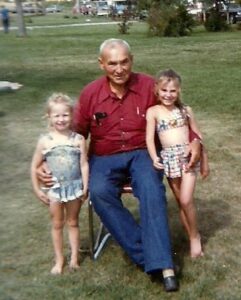
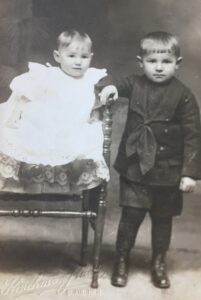 with the invention of the television, it was by no means perfected, and so he basically had the visitors who came in and books for entertainment. Not much fun really, especially since a lot of boys aren’t terribly interested in reading. Thankfully for Grandpa, his family tried to rally around him, and he received a number of postcard letters during that time. I would imagine he lived for the mail delivery, hoping he got a letter, after which he devoured the words on the page, even if the writer didn’t always pick their words very carefully. It was his connection to the outside world.
with the invention of the television, it was by no means perfected, and so he basically had the visitors who came in and books for entertainment. Not much fun really, especially since a lot of boys aren’t terribly interested in reading. Thankfully for Grandpa, his family tried to rally around him, and he received a number of postcard letters during that time. I would imagine he lived for the mail delivery, hoping he got a letter, after which he devoured the words on the page, even if the writer didn’t always pick their words very carefully. It was his connection to the outside world.
Grandpa was fitted with a wooden peg leg, but it would still be a long road learning to walk with it. I never knew exactly how high the leg went, but I believe it was probably mid-thigh. It was during this time that Grandpa would show his true fortitude He could have laid in that bed, giving up and letting other people take care of him, but he didn’t do that. He got up and worked hard to recover his mobility. Sure, he knew that things would never be the same, but he had things he wanted to do, and he was determined not to let this take him out of commission.
He went on to become the Sheriff of Rosebud County. One might think that he would never want anything to do with guns again, but while he didn’t really see the need for them much as sheriff, he was still well able to use 
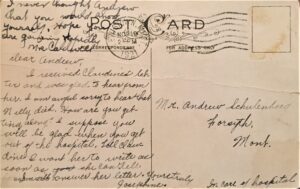 them. He was sheriff between 1955 and 1972, and during that time, he was well known as “the sheriff without a gun.” It’s hard to imagine a sheriff who has a reputation big enough to be able to work without a gun, including making arrests, but that was what he did. I don’t know if guns bothered him or not, but if so, he was quite successful at hiding it. Today is the 116th anniversary of Grandpa’s birth. Happy birthday in Heaven, Grandpa Schulenberg!! We love and miss you very much.
them. He was sheriff between 1955 and 1972, and during that time, he was well known as “the sheriff without a gun.” It’s hard to imagine a sheriff who has a reputation big enough to be able to work without a gun, including making arrests, but that was what he did. I don’t know if guns bothered him or not, but if so, he was quite successful at hiding it. Today is the 116th anniversary of Grandpa’s birth. Happy birthday in Heaven, Grandpa Schulenberg!! We love and miss you very much.
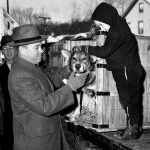
 As most of us know, dogs have been used in many kinds of work from K-9 units to military units to guide dogs, to cadaver dogs, and many more. During World War II, one such dog named Chips, who was a Shepherd-Collie-Husky mix, served for 3.5 years of the war. When the US entered World War II, the military actually asked Americans to “donate” their dogs to serve on patrols and guard duty. That seems so strange to me. How could the dog know what was going on? How could it not get depressed or aggressive, thinking its owner was dead or had abandoned it? It’s one thing to send a soldier into a war situation, they have either been legally drafted or they freely joined up, but a dog…or any animal for that matter, couldn’t possibly understand why, after having a family of their own, they were suddenly in a foreign country, without their owner, their own bed, or their home.
As most of us know, dogs have been used in many kinds of work from K-9 units to military units to guide dogs, to cadaver dogs, and many more. During World War II, one such dog named Chips, who was a Shepherd-Collie-Husky mix, served for 3.5 years of the war. When the US entered World War II, the military actually asked Americans to “donate” their dogs to serve on patrols and guard duty. That seems so strange to me. How could the dog know what was going on? How could it not get depressed or aggressive, thinking its owner was dead or had abandoned it? It’s one thing to send a soldier into a war situation, they have either been legally drafted or they freely joined up, but a dog…or any animal for that matter, couldn’t possibly understand why, after having a family of their own, they were suddenly in a foreign country, without their owner, their own bed, or their home.
Nevertheless, when their country asked, over 11,000 Americans volunteered their pets, including Chips’s owner, John Wren of Pleasantville, New York. Chips the first “volunteer” dog in the United States, took part in the invasion of Sicily, just a year into his deployment. When an Italian machine gunner pinned down Chips and his squad, he broke away from his leash and charged into the enemy position. A single shot rang out. Then, the Italian gunner emerged with Chips at his throat, followed by three more soldiers. They all quickly surrendered. Chips received a wound on his scalp and burns on his mouth and left eye. That didn’t stop this hero dog, who kept fighting and helped capture 10 more soldiers that day.
After the war, per their request, it was time for Chips to be returned to his family. Plans would have to be put in place for that to happen. So, in the fall of 1945 he was taken back to Front Royal where he was retrained so that he could go back to his family. A dog who had been in combat couldn’t just go back to his family as if nothing had happened. Finally in December of 1945, he traveled home to Pleasantville, riding in the baggage car of a train. He didn’t go alone. He was accompanied by six reporters and photographers who wanted to 
 cover the story. They were met by Mr and Mrs Wren and their son, Johnny, who was only a baby when Chips left. The girls raced home after school to see their dog. It was a sweet homecoming. Chips lived for just four months before his kidneys failed. I guess war had taken its toll.
cover the story. They were met by Mr and Mrs Wren and their son, Johnny, who was only a baby when Chips left. The girls raced home after school to see their dog. It was a sweet homecoming. Chips lived for just four months before his kidneys failed. I guess war had taken its toll.
Chips’s story made him an international sensation. He received a Silver Star for his heroics. Unfortunately, some people thought that a dog shouldn’t be awarded the same medal as a human, so it was revoked. Then, in 2018, he was awarded the PDSA Dickin Award, the highest honor for wartime bravery for an animal. A well-deserved honor. While his award was amazing, I think that the family should have also received an award, as should all of the other families who donated their dogs for the war effort. It was a very selfless act.

 The day after the debut of the Barbi doll on March 9, 1959, at the American Toy Fair in New York City, the doll had become an instant sensation. Basically, her debut makes Barbie 63 years old. The old girl has aged very well. In fact, she hasn’t aged a bit, although she can’t say she hasn’t had any work done. The reality is that Barbie has been redesigned at least every year. Of course, that isn’t saying she has had plastic surgery…or is it? She is, after all, made of plastic.
The day after the debut of the Barbi doll on March 9, 1959, at the American Toy Fair in New York City, the doll had become an instant sensation. Basically, her debut makes Barbie 63 years old. The old girl has aged very well. In fact, she hasn’t aged a bit, although she can’t say she hasn’t had any work done. The reality is that Barbie has been redesigned at least every year. Of course, that isn’t saying she has had plastic surgery…or is it? She is, after all, made of plastic.
Barbie stands eleven inches tall, and at first anyway, had long blond hair. These days, of course as hairstyles have changed and it was decided that not all girls are blonds, her hair color and style have changed with the times. She has been given lots of cool clothes, shoes, a house, car, RV, and boat…and probably many other things. Barbie was the first mass-produced toy doll in the United States with adult features. I suppose that she caused quite a stir with many parents, but for girls everywhere, she was the princess they were going to be when they grew up. I know I couldn’t wait to get one.
The woman behind Barbie was Ruth Handler, who co-founded Mattel, Inc with her husband in 1945. Handler witnessed her young daughter ignore her baby dolls to play make-believe with paper dolls of adult women, at which point she realized there was an important niche in the market for a toy that allowed little girls to imagine the future. Barbie’s appearance was modeled on a doll named Lilli, based on a German comic strip character. Lilli was originally marketed as a racy gag gift to adult men in tobacco shops, but she later became extremely popular with children. Mattel bought the rights to Lilli and made its own version, which Handler named after her daughter, Barbara.
In 1955, Mattel became a sponsor of the “Mickey Mouse Club” TV program. With that, Mattel became one of the first toy companies to broadcast commercials aimed specifically at children. They used their commercials to promote their new toy, and by 1961, the enormous consumer demand for the doll led Mattel to release a boyfriend for Barbie. Handler named him Ken, after her son. Then, Barbie’s best friend, Midge, came out in 1963; her little sister, Skipper, debuted in 1964.
Of course, the Barbie doll was not without controversy. On a positive note, many women saw Barbie as providing an alternative to traditional 1950s gender roles. Her many careers, like airline stewardess, doctor, pilot, astronaut, Olympic athlete, and even US presidential candidate made some women see a possible future that was different 
 than was common in the 1950s. Others thought Barbie’s never-ending supply of designer outfits, cars, and “Dream Houses” encouraged kids to be materialistic. However, the biggest controversy was over Barbie’s appearance. Her figure was unrealistic for a real woman. It was estimated that if she were a real woman, her measurements would be 36-18-38–led many to claim that Barbie provided little girls with an unrealistic and harmful example and fostered negative body image. Nevertheless, even with the criticism, Barbie never lost her appeal, and in fact she is as popular today as she ever was. I was just 3 years old when Barbie came out, and today, my great granddaughter, Cambree Petersen loves her Barbie dolls as much as I did, even if Barbie is…old!!!
than was common in the 1950s. Others thought Barbie’s never-ending supply of designer outfits, cars, and “Dream Houses” encouraged kids to be materialistic. However, the biggest controversy was over Barbie’s appearance. Her figure was unrealistic for a real woman. It was estimated that if she were a real woman, her measurements would be 36-18-38–led many to claim that Barbie provided little girls with an unrealistic and harmful example and fostered negative body image. Nevertheless, even with the criticism, Barbie never lost her appeal, and in fact she is as popular today as she ever was. I was just 3 years old when Barbie came out, and today, my great granddaughter, Cambree Petersen loves her Barbie dolls as much as I did, even if Barbie is…old!!!

 My grandniece, Manuela Ortiz (Renville) is a sweet girl, who is full of life and joy. She married my grandnephew, James Renville last summer, and they have been enjoying their new life together. They both love to travel, and they go as much as they can. I think their favorite places will most likely always include beaches. Manuela, or Manu, as she is lovingly called by all who know her well, immigrated to the United States from Medellín, Antioquia, Columbia, and so she is used to the warm equatorial climate, making the warm beaches feel a lot like home. Still, she has adapted well to the cold northern climate too. Manuela and James love to go skiing and play in the snow, something Manuela probably never saw, until he moved here. They are open to all kinds of climates and will find a way to have fun anywhere.
My grandniece, Manuela Ortiz (Renville) is a sweet girl, who is full of life and joy. She married my grandnephew, James Renville last summer, and they have been enjoying their new life together. They both love to travel, and they go as much as they can. I think their favorite places will most likely always include beaches. Manuela, or Manu, as she is lovingly called by all who know her well, immigrated to the United States from Medellín, Antioquia, Columbia, and so she is used to the warm equatorial climate, making the warm beaches feel a lot like home. Still, she has adapted well to the cold northern climate too. Manuela and James love to go skiing and play in the snow, something Manuela probably never saw, until he moved here. They are open to all kinds of climates and will find a way to have fun anywhere.
Manuela has a bubbly personality and makes life fun for anyone who knows her. She has been such a wonderful blessing to my niece Toni Chase and her husband, Dave. For most of his life, James has been their only child, 
 and now they have been given a daughter (daughter-in-law, but they don’t think of her as just a daughter-in-law) to complete their family…until grandbabies can come along…someday, hehehe. I think that whenever James and Manuela decide to have children, they will make beautiful babies, and I can’t wait to see them. Manuela has been so good for James, because he has a more reserved personality, but she brings out the other side of him, the side he only shows to those he knows well. When they are ready to have children, they will be a beautiful mix of both of them.
and now they have been given a daughter (daughter-in-law, but they don’t think of her as just a daughter-in-law) to complete their family…until grandbabies can come along…someday, hehehe. I think that whenever James and Manuela decide to have children, they will make beautiful babies, and I can’t wait to see them. Manuela has been so good for James, because he has a more reserved personality, but she brings out the other side of him, the side he only shows to those he knows well. When they are ready to have children, they will be a beautiful mix of both of them.
Manuela loves to dance, and coming from Columbia, she knows all the cool dances of that area. Dances like the Salsa, and many others that I would not know the names of, come as naturally to Manuela as walking, because she comes from a culture where these things are a part of everyday life. In fact, it is really fun to watch her dance, because she is so good at it. James can dance, but like most of us in this family, it is not something we do every day, so Manuela has been teaching him these dances, and he is getting very good as well. I’m sure 
 that comes as part natural ability and part having a great teacher. James is such a good man, and I know that whether he is a natural at dancing or not, Manuela’s family loves him just because he is who he is…as good a husband to Manuela and she is a wife to him. Speaking of teaching, this happens to be one of Manuela’s many talents! She is also teaching James Spanish and loves to make tic-toc videos to share his progress. They are pretty funny to watch. She also teaches English on-line to private students. She is a great teacher! She is a podcaster in her free time on YouTube at Con Manu en la sala and a Tik-Tok @manuejames. As they go through their lives, I know that they will continue to be a blessing to each other and to their families. Today is Manuela’s birthday. Happy birthday Manuela!! Have a great day!! We love you!!
that comes as part natural ability and part having a great teacher. James is such a good man, and I know that whether he is a natural at dancing or not, Manuela’s family loves him just because he is who he is…as good a husband to Manuela and she is a wife to him. Speaking of teaching, this happens to be one of Manuela’s many talents! She is also teaching James Spanish and loves to make tic-toc videos to share his progress. They are pretty funny to watch. She also teaches English on-line to private students. She is a great teacher! She is a podcaster in her free time on YouTube at Con Manu en la sala and a Tik-Tok @manuejames. As they go through their lives, I know that they will continue to be a blessing to each other and to their families. Today is Manuela’s birthday. Happy birthday Manuela!! Have a great day!! We love you!!
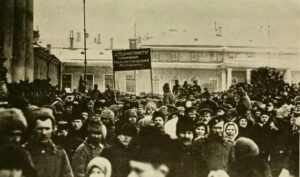 How can the February Revolution begin on March 8th, you might ask? Well, if you know much about 1917 Russia, you know that the calendar at that time was the Julian calendar, and not the Gregorian calendar that we use today in most countries. That was how the February Revolution (known as such because of Russia’s use of the Julian calendar) which began on February 23rd in the Julian calendar, actually began on March 8th in the now-used Gregorian calendar. The February Revolution started with riots and strikes over the scarcity of food erupt in Petrograd. One week later, centuries of czarist rule in Russia ended with the abdication of Czar Nicholas II, and Russia took a dramatic step closer to a communist revolution.
How can the February Revolution begin on March 8th, you might ask? Well, if you know much about 1917 Russia, you know that the calendar at that time was the Julian calendar, and not the Gregorian calendar that we use today in most countries. That was how the February Revolution (known as such because of Russia’s use of the Julian calendar) which began on February 23rd in the Julian calendar, actually began on March 8th in the now-used Gregorian calendar. The February Revolution started with riots and strikes over the scarcity of food erupt in Petrograd. One week later, centuries of czarist rule in Russia ended with the abdication of Czar Nicholas II, and Russia took a dramatic step closer to a communist revolution.
By 1917, Czar Nicholas II had already lost all of his credibility. The corruption in the government was rampant, the economy was a mess, and Nicholas repeatedly dissolved the Duma…the Russian parliament established after the Revolution of 1905…whenever it opposed his will. All that was bad, but the immediate cause of the February Revolution, which was the first phase of the Russian Revolution of 1917…was Russia’s disastrous involvement in World War I. Militarily, Russia was no match for industrialized Germany, and Russian casualties were greater than those sustained by any nation in any previous war. They were severely pounded by the Germans. Meanwhile, the economy was hopelessly disrupted by the costly war effort, and moderates joined Russian radical elements in calling for the overthrow of the czar, who was already weak due to family problems, namely a sick child.
While most of the world switched from the Julian calendar to the Gregorian calendar in 1582, Russia didn’t make the conversion until 1918. So, 104 years ago, the Russian people irrevocably had half a month wiped out of their lives…13 days of February in 1918. Their calendar went from January 31, 1918, to February 14, 1918…overnight. On March 8th or February 23rd, 1917, depending on the calendar you choose to use for the event, demonstrators were clamoring for bread in the streets of the Russian capital of Petrograd (now known as Saint Petersburg). Supported by 90,000 men and women on strike, the protesters clashed with police but refused to leave the streets. The strike spread, and on March 10th, it had spread among all of Petrograd’s workers, and irate mobs of workers destroyed police stations. Several factories elected deputies to the Petrograd Soviet, or “council” of workers’ committees, following the model devised during the Revolution of 1905.
By March 11th, the troops of the Petrograd army garrison ordered soldiers to crush the uprising. Regiments opened fire, killing demonstrators, but the protesters kept to the streets, and the troops began to waver. Nicholas dissolved the Duma again on that day, and on March 12, the revolution triumphed when regiment after regiment of the Petrograd garrison defected to the cause of the demonstrators. The soldiers, some 150,000 men, subsequently formed committees that elected deputies to the Petrograd Soviet.
The uprising forced the imperial government to resign, and the Duma formed a provisional government that peacefully vied with the Petrograd Soviet for control of the revolution. March 14th, saw the Petrograd Soviet  issuing “Order No. 1,” which instructed Russian soldiers and sailors to obey only those orders that did not conflict with the directives of the Soviet. Czar Nicholas II abdicated the throne the next day, March 15th, in favor of his brother Michael, who refused the crown, ending the czarist autocracy.
issuing “Order No. 1,” which instructed Russian soldiers and sailors to obey only those orders that did not conflict with the directives of the Soviet. Czar Nicholas II abdicated the throne the next day, March 15th, in favor of his brother Michael, who refused the crown, ending the czarist autocracy.
The Petrograd Soviet tolerated the new provincial government and hoped to salvage the Russian war effort while ending the food shortage and many other domestic crises…a daunting task. Meanwhile, Vladimir Lenin, leader of the Bolshevik revolutionary party, left his exile in Switzerland and crossed German enemy lines to return home and take control of the Russian Revolution.

